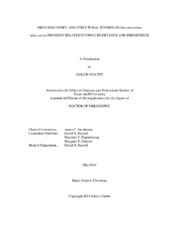| dc.description.abstract | Mycobacterium tuberculosis (Mtb) is the causative agent of tuberculosis (TB), which is one of the leading infectious diseases worldwide. The current therapy for drug-sensitive TB is complex and lasts for at least six months. Improper use of antibiotics during this regimen has led to the emergence of drug resistance, which represents a grave threat to human health. This problem is further exacerbated by the ability of the bacterium to persist in the host in a non-replicating state despite the use of antibiotics. The majority of antibiotics currently used to treat tuberculosis only affect replicating bacteria. Therefore, it is critical to develop new antitubercular drugs that can shorten the current therapy while maintaining activity against persistent bacteria as well as the drug-resistant strains. In this dissertation, structural and drug discovery studies on Mtb proteins related to drug resistance and persistence are presented.
InhA, the enoyl-ACP-reductase enzyme of the mycolic acid biosynthesis pathway, is the molecular target of the antitubercular prodrugs isoniazid and ethionamide, and it is one of the best validated targets for Mtb drug discovery. A target-based high throughput screening and a structure-based drug design were performed to identify potent activation-free InhA inhibitors that were effective against drug-resistant Mtb strains. The molecular basis of InhA inhibition by these inhibitors was revealed by X-ray crystallography. In addition, the mode of action for ethionamide was revealed by using a cell-based activation system and X-ray crystallography. Furthermore, it was demonstrated that InhA is the clinically relevant primary target of isoniazid. The regulation of InhA function was also studied, which revealed that phosphorylation of InhA occurs at its C-terminal. Phosphomimetic mutants showed that phosphorylation decreases InhA activity by decreasing the affinity toward cofactor NADH. The results of these studies are presented in Chapters II, III, IV, and V.
It is essential to understand the physiology of the bacterium to target the persistent state of Mtb infection. In Chapter VI, I report our studies on CarD, an essential Mtb transcription regulator that is required for persistent infection. The structure of the CarD/RNAP complex was determined by X-ray crystallography and the CarD-DNA interactions were investigated. | en |


